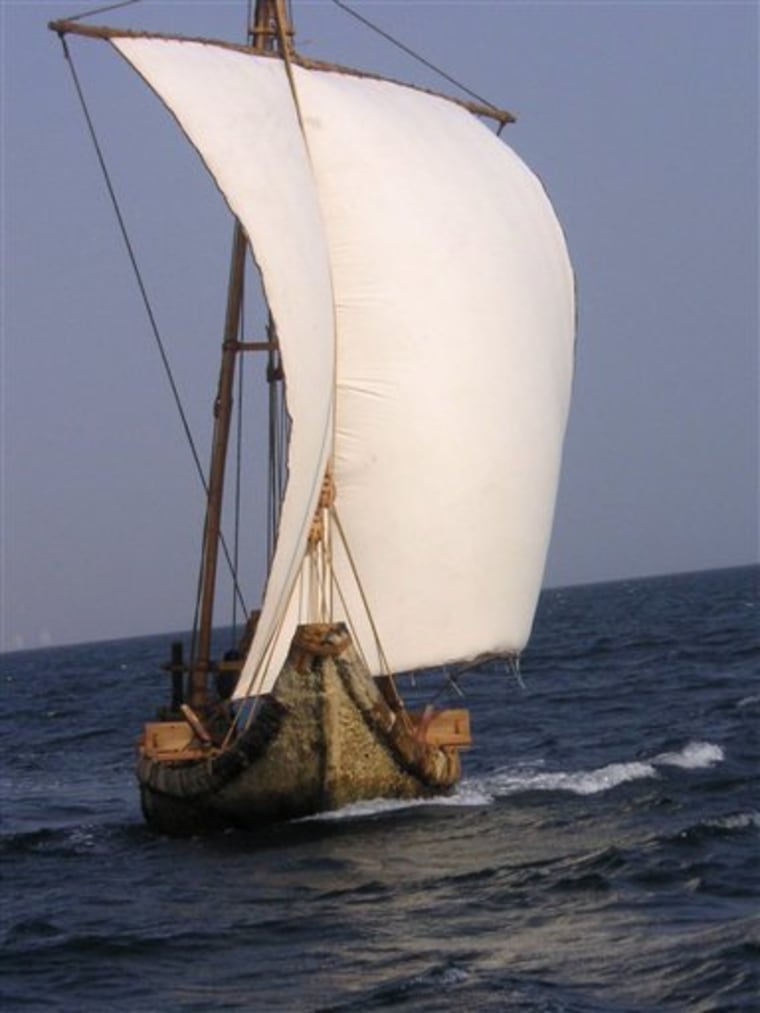It was a quick end for a Bronze Age-style boat of reeds and tar, sinking just after leaving Oman on a voyage across the Indian Ocean. But its crew vowed Saturday to try again to prove that traders 4,000 years ago could have made the journey to India.
The 40-foot boat, dubbed the Magan after an ancient name for Oman, set sail Wednesday from the Gulf sultanate’s port of Sur but several miles offshore it started to take on water and sank within 30 minutes.
Its eight-member crew — two Americans, an Australian sailing master, two Omani seamen, two Italian graduate students and an Indian archaeologist — tried to bail out the water but soon had to escape on a life raft to an Omani ship escorting the Magan, the crew said in a statement.
The boat was made from reeds, date-palm fibers and bitumen tar, with a wool sail and two teak oars. The team was hoping to make the 600 mile voyage across the Indian Ocean to the historic Indian port of Mandvi to follow what archaeologists believe was a Bronze Age trade route.
But high seas gushed through a part of the boat’s hull just below the rim that was not covered in the tar used for waterproofing and reinforcement.
“The rim was not waterproof up to the top and the boat’s bitumen amalgam coating finished 30 centimeters (12 inches) below the rim,” said Maurizio Tosi of the University of Bologna, which was behind the project when it started in 1999.
The boat tilted more than expected, “which contributed to the faster entry of water” into the vessel, Tosi said.
The Magan will not be retrieved from the bottom of the Arabian Sea, said archaeologist Gregory L. Possehl, a co-chairman of the project and curator at the University of Pennsylvania Museum of Archaeology and Anthropology in Philadelphia.
“Everyone was very saddened by the sinking of the boat on the first day,” Possehl told The Associated Press by telephone from Oman. “It was a tragedy, especially after it had gotten off to a good start.”
Tosi and Possehl were both aboard the Omani vessel that, along with an Indian Navy ship, shadowed the Magan and rescued the crew.
On a positive note, Omani Culture Minister Saeed Haithem told the members of the boat project Saturday that his government will back the rebuilding and testing of another boat, Possehl said.
About $250,000 in funding provided by the Omani government had gone into the project, said Tosi, who believed a greater amount would be spent on rebuilding two more vessels.
The Magan was skippered by Tom Vosmer, the vessel’s American director of design and construction who know lives in Western Australia.
The project began after excavations on the easternmost point of the Saudi Arabian peninsula turned up fragments of bitumen with the impressions of bound reeds and rope lashings on one side and barnacles on the other side. The find was evidence, researchers said, of construction of vessels in the Arabian Sea during the Bronze Age.
The boat was built based on that evidence along with ancient texts and images. Although researchers aren’t calling it a replica — there isn’t enough evidence for that — it represents their best guess about how such a vessel might have been built 4,500 years ago.
Researchers had hoped the voyage would help them learn about Bronze Age boat construction techniques, plus how well such vessels worked, how to sail them, and what life aboard them might have been like.
